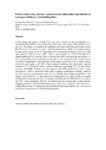Mostrar o rexistro simple do ítem
Effects of pH, CO2, and flow pattern on the autotrophic degradation of hydrogen sulfide in a biotrickling filter
| dc.contributor.author | Jin, Yaomin | |
| dc.contributor.author | Veiga, María Carmen | |
| dc.contributor.author | Kennes, Christian | |
| dc.date.accessioned | 2014-11-05T15:18:15Z | |
| dc.date.available | 2014-11-05T15:18:15Z | |
| dc.date.issued | 2005-11 | |
| dc.identifier.citation | Jin Y, Veiga MC, Kennes C. Effects of pH, CO2, and flow pattern on the autotrophic degradation of hydrogen sulfide in a biotrickling filter. Biotechnol Bioeng. 2005;92(4):462- 71 | es_ES |
| dc.identifier.other | OI: 10.1002/bit.20607 | |
| dc.identifier.uri | http://hdl.handle.net/2183/13772 | |
| dc.description.abstract | In this study, the effects of pH, CO2, and flow pattern on the performance of a biotrickling filter (BTF) packed with plastic Pall rings and treating a H2S-polluted waste gas were investigated to establish the optimum operating conditions and design criteria. The CO2 concentration had no effect on the biodegradation at H2S concentrations below 50 ppm. In the range of 50–127 ppm H2S, CO2 concentrations between 865 and 1,087 ppm enhanced H2S removal, while higher concentrations of 1,309–4,009 ppm CO2 slightly inhibited H2S removal. The co-current flow BTF presented the advantage of a more uniform H2S removal and biomass growth in each section than the counter-current flow BTF. Examination of the pH-effect in the range of pH 2.00–7.00 revealed optimal activity for autotrophs at pH 6.00. Under optimal conditions, the elimination capacity reached 31.12 g H2S/m3/h with a removal efficiency exceeding 97%. In the present research, autotrophic biomass was developed in the BTF, performing both a partial oxidization of H2S to elemental sulfur and a complete oxidization to sulfate, which is favorable from an environmental point of view. Results showed that around 60% of the sulfide concentration fed to the reactor was transformed into sulfate. Such autotrophic trickling filters may present other advantages, including the fact that they do not release any CO2 to the atmosphere. Besides, the limited growth of autotrophs avoids potential clogging problems. Experimental performance data were compared with data from a mathematical model. Comparisons showed that the theoretical model was successful in predicting the performance of the biotrickling filter. | es_ES |
| dc.language.iso | eng | es_ES |
| dc.publisher | Wiley-Blackwell | es_ES |
| dc.relation.uri | http://dx.doi.org/10.1002/bit.20607 | es_ES |
| dc.rights | The definitive version is available at http://onlinelibrary.wiley.com/ | es_ES |
| dc.subject | Hydrogen sulfide | es_ES |
| dc.subject | Flow pattern | es_ES |
| dc.subject | pH | es_ES |
| dc.subject | Autotrophy | es_ES |
| dc.subject | CO2 | es_ES |
| dc.subject | Pall rings | es_ES |
| dc.title | Effects of pH, CO2, and flow pattern on the autotrophic degradation of hydrogen sulfide in a biotrickling filter | es_ES |
| dc.type | info:eu-repo/semantics/article | es_ES |
| dc.rights.access | info:eu-repo/semantics/openAccess | es_ES |
Ficheiros no ítem
Este ítem aparece na(s) seguinte(s) colección(s)
-
GI-BIOENGIN- Artigos [106]






